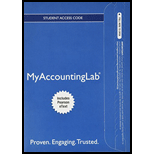
Evaluating ratio data
| Learning Objective 5 |
Abanaki Carpets reported the following amounts in its 2018 financial statements. The 2011 figures are given for comparison.
| 2018 2017 | |
| Balance sheet partial Current Assets: Cash Short-term Investments Less: Allowance far Merchandise Inventory Prepaid Insurance Total Current Assets Total Current Liabilities Income statement partial Net Sales (all on account) |
$ 5,000 $ 11.000 25,000 14,000 $ 64000 $ 77.000 (7.000) 57,000 (6,000) 71000 194.000 190.000 2,000 2.000 283,000 288,000 105,000 107,000 742,400 730,000 |
Requirements
1. Calculate Abanaki’s acid-test ratio for 2018. (Round to two decimals.) Determine whether Abanaki’s acid-test ratio improved or deteriorated from 2017 to 2018. How does Abanaki’s acid-test ratio compare with the industry average of 0.80?
2. Calculate Abanaki’s accounts receivable turnover ratio. (Round to two decimals.) How does Abanaki’s ratio compare to the industry average accounts receivable turnover of 10?
3. Calculate the days’ sales in receivables for 2018. (Round to the nearest day.) How do the results compare with Abanaki’s credit terms of net 30?
Want to see the full answer?
Check out a sample textbook solution
Chapter 9 Solutions
Myaccountinglab With Pearson Etext -- Access Card -- For Horngren's Accounting, The Managerial Chapters
- (Learning Objectives 1, 7: Show how to speed up cash flow from receivables;evaluate liquidity through ratios) Norfolk Co., Inc., an electronics and appliance chain,reported these figures in millions of dollars:Net sales .........................................Receivables at end of year...............2019$398,5003,8602018$418,5004,110Requirements1. Compute Norfolk’s days’ sales in receivables or days’ sales outstanding (DSO) during 2019.(For this exercise, use “net sales” for “net credit sales” when calculating ratios.)2. Is Norfolk’s DSO long or short? Nico Networks takes 39 days to collect its average levelof receivables. Divencenzo, the overnight shipper, takes 33 days. What causes Norfolk’scollection period to be so different?arrow_forward(Learning Objectives 1, 7: Show how to speed up cash flow from receivables;evaluate liquidity through ratios) Geneva Co., Inc., an electronics and appliance chain,reported these figures in millions of dollars:Net sales .........................................Receivables at end of year...............2019$523,1253,8602018$543,1254,510Requirements1. Compute Geneva’s days’ sales in receivables or days’ sales outstanding (DSO) during2019. (For this exercise, use “net sales” for “net credit sales” when calculating ratios.)2. Is Geneva’s DSO long or short? Kurzwel Networks takes 39 days to collect its averagelevel of receivables. Domarko Freight, the overnight shipper, takes 33 days. What causesGeneva’s collection period to be so different?arrow_forward

 AccountingAccountingISBN:9781337272094Author:WARREN, Carl S., Reeve, James M., Duchac, Jonathan E.Publisher:Cengage Learning,
AccountingAccountingISBN:9781337272094Author:WARREN, Carl S., Reeve, James M., Duchac, Jonathan E.Publisher:Cengage Learning, Accounting Information SystemsAccountingISBN:9781337619202Author:Hall, James A.Publisher:Cengage Learning,
Accounting Information SystemsAccountingISBN:9781337619202Author:Hall, James A.Publisher:Cengage Learning, Horngren's Cost Accounting: A Managerial Emphasis...AccountingISBN:9780134475585Author:Srikant M. Datar, Madhav V. RajanPublisher:PEARSON
Horngren's Cost Accounting: A Managerial Emphasis...AccountingISBN:9780134475585Author:Srikant M. Datar, Madhav V. RajanPublisher:PEARSON Intermediate AccountingAccountingISBN:9781259722660Author:J. David Spiceland, Mark W. Nelson, Wayne M ThomasPublisher:McGraw-Hill Education
Intermediate AccountingAccountingISBN:9781259722660Author:J. David Spiceland, Mark W. Nelson, Wayne M ThomasPublisher:McGraw-Hill Education Financial and Managerial AccountingAccountingISBN:9781259726705Author:John J Wild, Ken W. Shaw, Barbara Chiappetta Fundamental Accounting PrinciplesPublisher:McGraw-Hill Education
Financial and Managerial AccountingAccountingISBN:9781259726705Author:John J Wild, Ken W. Shaw, Barbara Chiappetta Fundamental Accounting PrinciplesPublisher:McGraw-Hill Education





